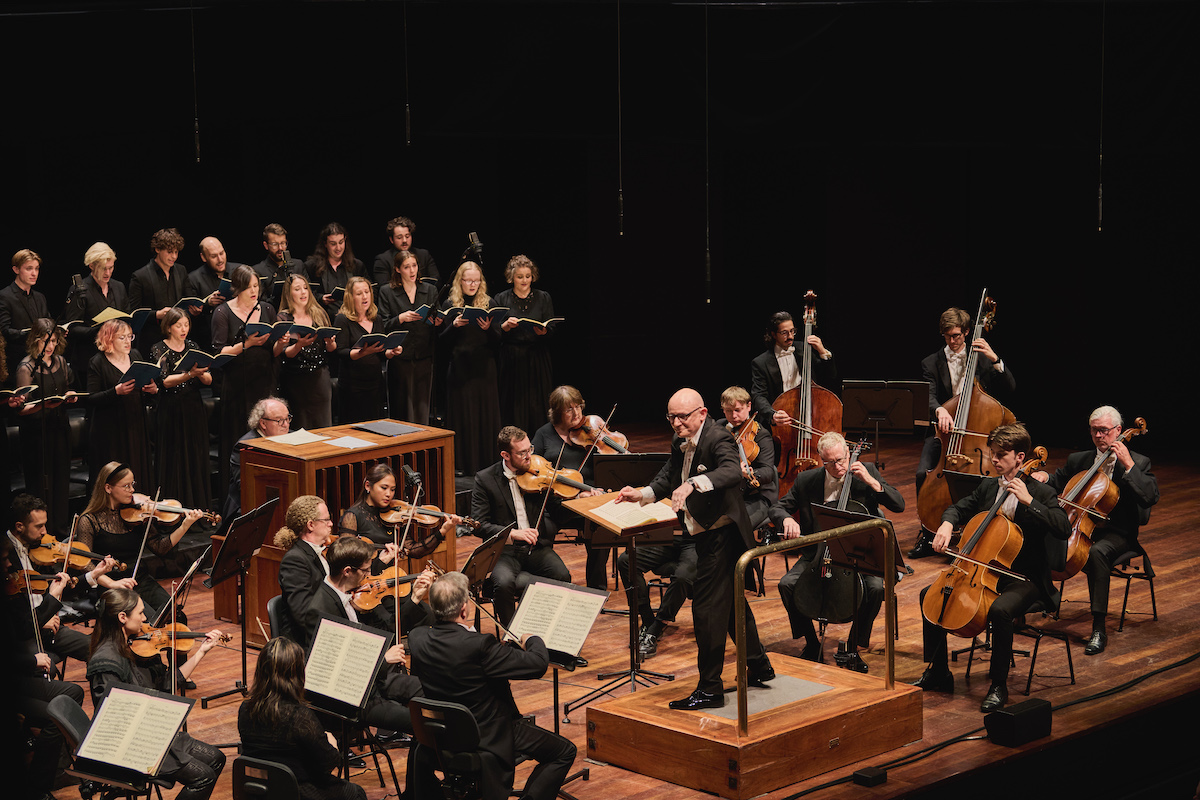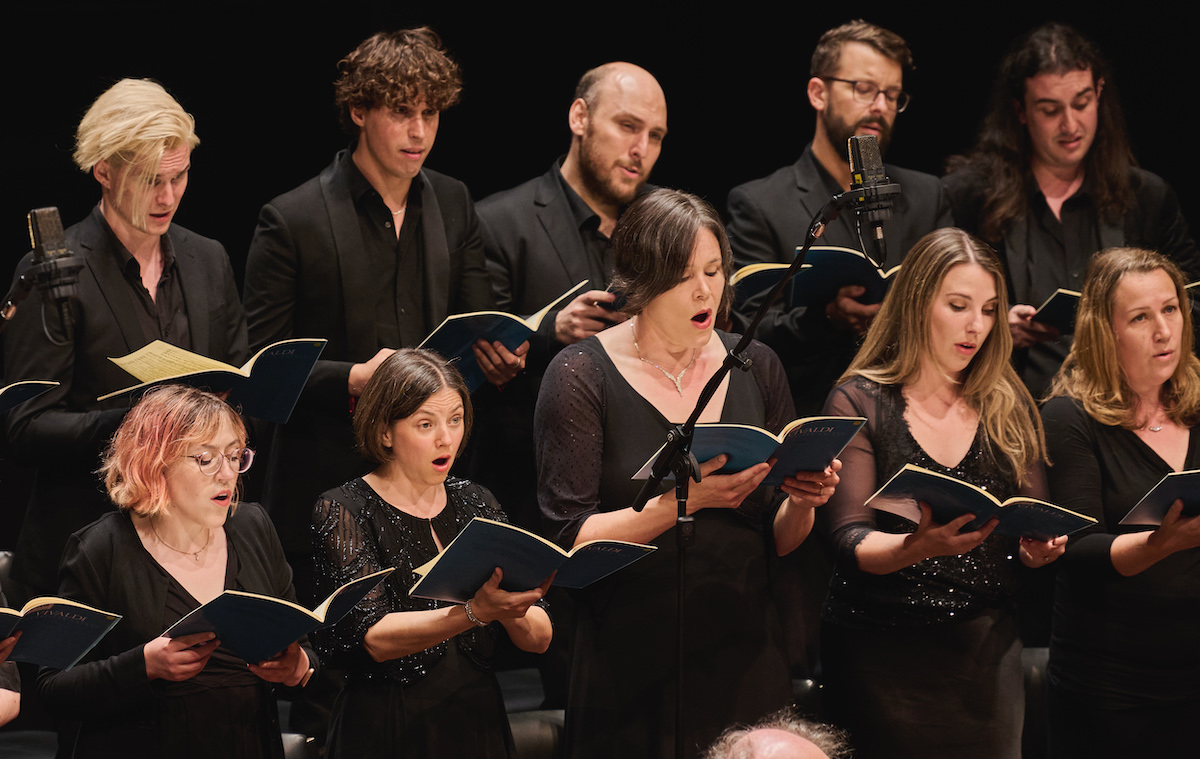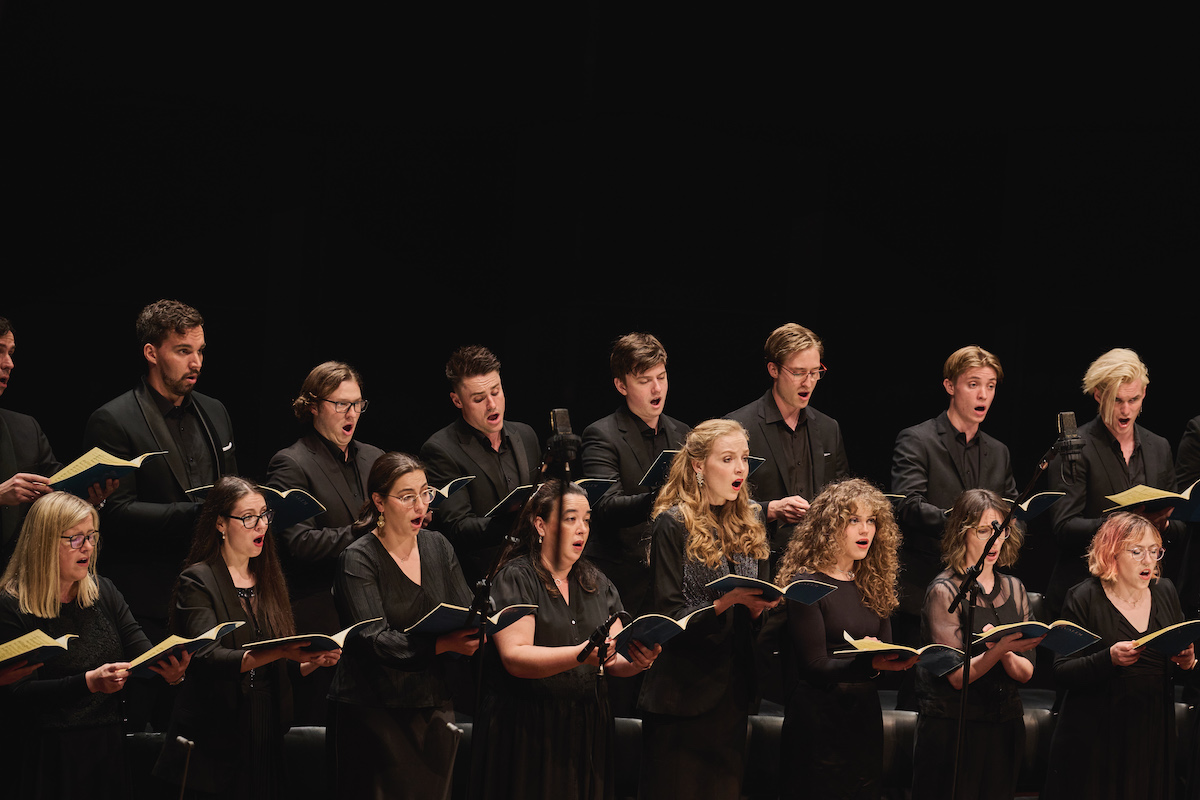It would be difficult to imagine a better program than this Easter offering to showcase Joseph Nolan’s penchant for wringing every drop of colour and drama from the music he plays or conducts. Indeed, as booklet note author Yvonne Frindle writes, “There is something intrinsically theatrical in both the Vivaldi and the Handel works … we experience Italianate fire and extravagance.”
However, before exploding in Technicolor, this near sold-out concert began in mournful monochrome as acclaimed organist and choral conductor Nolan coaxed from the superb St Georges Cathedral Consort a moving rendition of English Renaissance composer Thomas Weelkes’ sacred madrigal, When David Heard.

Joseph Nolan conducts St George’s Cathedral Consort and WASO’s Gloria. Photo © Rebecca Mansell
Weelkes’ six-part setting of the Old Testament’s 2 Sam 18:33, in which King David laments the death of his son, Absalom, is a concise study in communicating paternal grief through music. Nolan’s achievement here was to recognise and relate the perfection of Weelkes’ art straining against the inexpressible.
Vivaldi’s celebrated c.1715 concertato setting of the mass’s Gloria, RV589, barely needs any introduction: the challenge in performance, as Nolan points out, is to make it sound fresh each time. And this time? Job done, Maestro!
From the throbbing energy of the opening Gloria in excelsis Deo to the spectacular fugue of Cum Sancto Spiritu, this was an account in which the choir – from which the excellent soloists were drawn – and a small complement of WASO string players led by Laurence Jackson and joined by trumpet player Sarah Young, oboist Sarah Young and continuo organist Stewart Smith, under Nolan’s bold, imaginative direction, “made it new”.
The sense of anticipation with which the Et in terra pax was imbued. Lucinda Nicholls’ and Bonnie de la Hunty’s ecstatic duetting in the Laudamus te. The breadth and richness of the choral sound in the Gratias agimus tibi. Jackson’s fluent obbligato violin in pastoral conversation with Lucinda Nicholls. Isaac Davis’ similarly impressive cello accompaniment to Amber Lister’s Domine Deus, Agnus Dei, the latter a marvellous contrast to the concerto-like drama of Qui sedes ad dexteram Patris … so many highlights, so much to relish.

St George’s Cathedral Consort and WASO’s Gloria. Photo © Rebecca Mansell
And yet the best was yet to come when, following a brief interval, Nolan unleashed the unbridled theatricality of Handel’s youthful masterpiece, a product of his Italian apprenticeship, the Dixit Dominus HWV232, completed in Rome in 1707, on an already-pumped audience.
As far as performers are concerned, this setting of Psalm 110 is not for the faint-hearted. As conductor Sir Eliot Gardiner has written in relation to it: “Handel is pitiless in the demands he makes of his musicians in the course of the eight movements.”
While presumably not pitiless, Nolan must nevertheless be an uncompromising taskmaster to have brought his ensemble to this level of singing. Thinking of the quality of the individual singers alone, one was immediately impressed by the florid solo work of Sabra Poole-Johnson, Anita Saxby, Jason Kroll and Lachlann Lawton in the opening movement and, further along, the astonishing agility of Anne-Marie Duce, Poole-Johnson, Bonnie de la Hunty, Lucinda Nicholls, Perry Joyce, Kroll and Lawton as they were swept along by Handel’s relentless forward motion.
Some of Handel’s more audacious experiments in word-painting, such as the ear-opening vocal effects in the Juravit Dominus and Conquassabit movements (the latter’s violence frighteningly recalling Purcell’s stuttering The Cold Song), were also animated with considerable vigour and precision.

St George’s Cathedral Consort and WASO’s Gloria. Photo © Rebecca Mansell
And that final tour-de-force that is the Gloria Patri? Layer upon goosebump-inducing layer of sinuous, rippling lines and fugal ecstasies, Nolan driving singers and players hard towards a triumphantly refulgent close.
Nolan clearly understands the human voice, and what it is capable of. But perhaps like Vivaldi, Handel and indeed Bach he also has an instrumental conception of the voice: this comes through in his tendency to shape phrases, paragraphs and sometimes even single tones with interpretative gestures that fall between sforzandi and organ-like swell effects.
This results in greater coherence between orchestra and singers, greater clarity of projection and a sweeping power that is both startling and insightful.
Any gripes will surely sound churlish. But if pressed, I’d have preferred to hear just one double bass in the strings and not two. And a greater consistency of vibrato among the vocal soloists.











Comments
Log in to join the conversation.